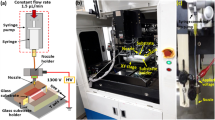Abstract
This paper describes the research, development and prototype of an electro-mechanic electrical discharge plotter system based on a three-axis Cartesian robot. The plotter can trace monochromatic arbitrary figures or alphanumeric characters on a given substrate such as paper without using any ink. A discharge probe delivering controlled electrical discharges is moved on the two-dimensional surface of the substrate using stepper motor-driven linear actuators to generate the arbitrary figures similar to CNC-based laser cutters and EDMs. The heat of the plasma evolved during the dielectric breakdown of ambient air during an electrical discharge or an arc has been used to create dark spots on the substrate by surface carburization. The discharge pulse duration, electrical parameters and the actuator movement are controlled by a microcontroller. The common printing systems currently available in the market give 300 to 600 DPI of resolution. However, the plotter prototype featured in this article plots with a resolution of 60 to 80 DPI which is enough to demonstrate. This technology can potentially eliminate the need for inks and toners which need frequent refilling. Every refilling invites considerable expenditure and significant environmental impact when their containing cartridges are discarded. This article only intends to put forward the possibility of such a printing technique and not propose the perfect alternative for existing printing systems.

















Similar content being viewed by others
Data availability material
No data were used from any kind of data repositories. The data presented here were sourced from published journals or papers and have been cited. The sources have been mentioned in the reference section of this manuscript.
Reference
Tang H, Kuek W, Gozali R, Liew R. Ink jet printer pioneers and competitors. In: Proc IEEE international conf on management of innovation and technology (Singapore). 2000;1:94–96.
Marmur A. Liquid penetration into porous media. In: Proc. IS&Ts NIP16 Int. conf. on digital printing technology. 2000:236–238.
Harriman D. Control systems challenges in the HP personal ink jet printing application. In: American control conference. 2005:1138–41.
Stephany T. Ink-Jet cartridge lifetime. J Microelectromech Syst. 2007;16:351–4.
Hirose K, Fukue T, Nakagawa F , Ito R, Wauke T ,Hoshino H, Terao H. Basic study on transient temperature response of papers in a thermal transfer printer. In: Proc ASME int electronic packaging technical conference and exhibition(InterPACK). 2013: 2
Shim JH, Cho HS. A New macro/micro robotic probing system for the in-circuit test of PCBs. Mechatronics. 1999;9:589–613.
Boulos M. Thermal plasma processing. IEEE Trans Plasma Sci. 1991;19:589–613.
Erfani R, Zare-Behtash H, Hale C, Kontis K. Development of DBD plasma actuators: the double encapsulated electrode. Acta Astronautica. 2015;109:132–43.
Larboulette C, Quesada P, Dumas O. Burning paper: simulation at the fibre’s level. In: Proc. ACM SIGGRAPH conf. on motions in game. 2013:25–30
Babrauskas V. Arc beads from fires: can ‘cause’ beads be distinguished from ‘victim’ beads by physical or chemical testing?. J Fire Protection Eng. 2004;14:125–47.
Amigó JM, Chanh NB. DTA study of thermal combustion of textile fibres. J Therm Anal. 1975;7:183–5.
Acknowledgements
The authors would like to thank Mr. Shylesh Srinivasan from Aura Labs at SRM Institute of Science and Technology for his help with the electrical systems used in the experimentation.
Funding
No external funding was put into this research work.
Author information
Authors and Affiliations
Contributions
Ms. Shilpa Thakur had contributed and developed the concepts involved in this work substantially. She was involved in the prototyping and experimentation of the hardware used to acquire the data and observations which are central to this research. She had drafted the manuscript, revised it critically of its intellectual content and has approved the final version of the publishable manuscript. She agrees to be accountable for all aspects of the research work and address any future queries regarding the work to satisfaction.
Dr. S. Prabhu had contributed in this research work and analysed data from experimentations and simulations. He had framed plans of action for the outcomes of the experimentations. He had also revised the manuscript critically for its intellectual content and had approved the final publishable manuscript.
Corresponding author
Ethics declarations
Ethics approval
Not applicable. This research work is not based on any form of personal or sensitive information pertaining to individuals or organizations.
Competing interests
It is assured that neither we (authors) nor would any individual or party would have any conflict of interest with the work presented here.
Consent for publication
All facts and figures presented here are either deduced by the authors through the research work done on the presented subject or are already available in the public domain. Thus, consent for publication of the presented material is implicit.
Additional information
Publisher's Note
Springer Nature remains neutral with regard to jurisdictional claims in published maps and institutional affiliations.
Rights and permissions
About this article
Cite this article
Thakur, S., Prabhu, S. Substrate surface carburization-based electro-mechanical plotter using plasma evolved during electrostatic breakdown of ambient air. J Therm Anal Calorim 147, 2823–2832 (2022). https://doi.org/10.1007/s10973-021-10595-8
Received:
Accepted:
Published:
Issue Date:
DOI: https://doi.org/10.1007/s10973-021-10595-8




